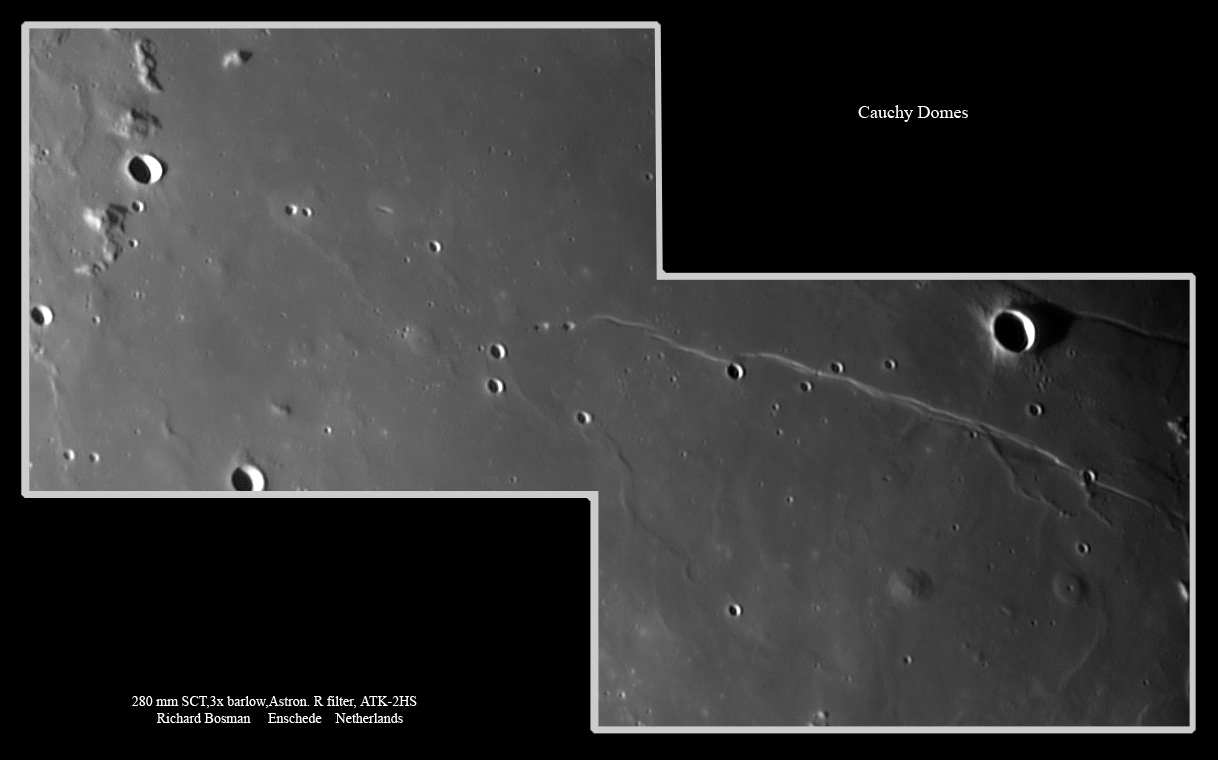|
|
| (7 intermediate revisions by the same user not shown) |
| Line 1: |
Line 1: |
| | __NOTOC__ | | __NOTOC__ |
| | =A Fault and a Gaggle of Domes= | | =A Fault and a Gaggle of Domes= |
| | + | <!-- Start of content --> |
| | + | <div class="post" id="post-626"> |
| | | | |
| − |
| + | <div class="storycontent"> |
| − | <div class="post" id="post-626">
| + | <p>[[File:Cauchy-Bosman.jpg|Cauchy-Bosman.jpg]]<br /> |
| − |
| |
| − | <div class="storycontent">
| |
| − | <p>[[File:Cauchy-Bosman.jpg|Cauchy-Bosman.jpg]]<br />
| |
| | <em>image by [mailto:richard@astrofotografie.nl Richard Bosman], Enschede, Netherlands</em></p> | | <em>image by [mailto:richard@astrofotografie.nl Richard Bosman], Enschede, Netherlands</em></p> |
| − | <p>The Cauchy area is one of the most fascinating places on the Moon. It includes one of the few major lunar faults, a nearby rille and a high concentration of domes. Richard comments that he can see 13 domes - how many do you count on his wonderful image? Some of the domes are classic hemispheric caps with a central pit, and a few - most obviously Cauchy Omega at the far right - have flattened summits, and Cauchy Tau (left of Omega) has an irregular surface with a small peak. I am intrigued by something I don’t remember seeing before. The rille at the base of the Cauchy Scarp is known - I published a description of it in 1966 - but I was unaware that at its eastern end the rille climbed up the scarp and continued a short distance across the mare. But after seeing it on Richard’s image a check shows that it is also barely visible on the oblique Apollo 8 [http://www.lpod.org/archive/archive/2004/01/LPOD-2004-01-02.htm view]. And after a gap, the western end of the rille continues a few kilometers further. As I look at the Apollo and especially Richard’s image I begin to question if the feature I call a rille actually is one, of if it is a smaller fault at the base of the big scarp. Actually, looking closely at the US Geological Survey’s [http://www.lpod.org/coppermine/displayimage.php?album=lastup&cat=0&pos=0 image] of the scarp makes it look like the feature is a narrow flat-topped ridge. This is confusing - perhaps someday the SMART-1 image of this area will be released, answering the question.</p> | + | <p>The Cauchy area is one of the most fascinating places on the Moon. It includes one of the few major lunar faults, a nearby rille and a high concentration of domes. Richard comments that he can see 13 domes - how many do you count on his wonderful image? Some of the domes are classic hemispheric caps with a central pit, and a few - most obviously Cauchy Omega at the far right - have flattened summits, and Cauchy Tau (left of Omega) has an irregular surface with a small peak. I am intrigued by something I don’t remember seeing before. The rille at the base of the Cauchy Scarp is known - I published a description of it in 1966 - but I was unaware that at its eastern end the rille climbed up the scarp and continued a short distance across the mare. But after seeing it on Richard’s image a check shows that it is also barely visible on the oblique Apollo 8 [[January_2,_2004|view]]. And after a gap, the western end of the rille continues a few kilometers further. As I look at the Apollo and especially Richard’s image I begin to question if the feature I call a rille actually is one, of if it is a smaller fault at the base of the big scarp. Actually, looking closely at the US Geological Survey’s [http://www.lpod.org/coppermine/displayimage.php?album=lastup&cat=0&pos=0 image] of the scarp makes it look like the feature is a narrow flat-topped ridge. This is confusing - perhaps someday the SMART-1 image of this area will be released, answering the question.</p> |
| | <p>[mailto:tychocrater@yahoo.com Chuck Wood]</p> | | <p>[mailto:tychocrater@yahoo.com Chuck Wood]</p> |
| | <p><b>Technical Details:</b><br /> | | <p><b>Technical Details:</b><br /> |
| Line 15: |
Line 14: |
| | Rükl plates ? <em>(don’t have the book with me)</em><br /> | | Rükl plates ? <em>(don’t have the book with me)</em><br /> |
| | [http://www.astrofotografie.nl/ Richard’s website]<br /> | | [http://www.astrofotografie.nl/ Richard’s website]<br /> |
| − | [http://www.lpod.org/archive/LPOD-2004-11-29.htm Paolo’s image of the area]</p> | + | [[November_29,_2004|Paolo’s image of the area]]</p> |
| − | <p align="center"> | + | <p><b>Yesterday's LPOD:</b> [[October 11, 2006|A Previously Unimaged Crater]] </p> |
| − | <i>Now you can support LPOD when you buy any book from Amazon thru [http://www.lpod.org/?page_id=102 LPOD!]</i></p> | + | <p><b>Tomorrow's LPOD:</b> [[October 13, 2006|Mercy, Mersenius!]] </p> |
| − | </div>
| + | <!-- Removed reference to store page 2 --> |
| − |
| + | </div> |
| − | | + | <!-- End of content --> |
| − | ---- | + | {{wiki/ArticleFooter}} |
| − | ===COMMENTS?===
| |
| − | Click on this icon [[image:PostIcon.jpg]] at the upper right to post a comment.
| |




